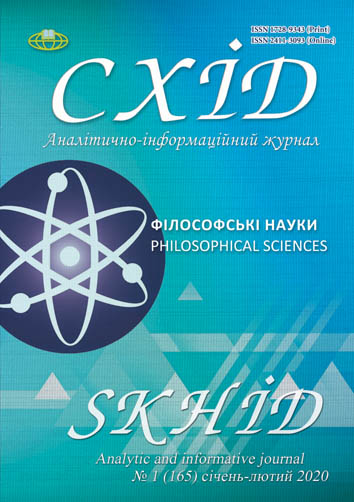The social and biological aspects of human death and social downshifting as a philosophical problem
DOI:
https://doi.org/10.21847/1728-9343.2020.1(165).196770Keywords:
social downshifting, human death, social identity, value functionalism, sanctity of life, quality of life, technological life-extension capabilitiesAbstract
Social downshifting is emerging as one of the key strategies of optimizing and maintaining the quality of human life in view of the prospect meet one's death with dignity. The aim of the issue is to conceptualize the term “social downshifting”, by analyzing the relationship between social and biological aspects of death and the connection of a person's understanding of his/her death with his/her social self-identification. In this study the functional approach was used in its value interpretation, that is, as a method of value functionalism. If social downshift emerges as a social value, it can have different functional consequences - institutional, organizational, communicative. On the other hand, the functional choice of a person in favor of social downshift as accepting a new value of the state of limited functional capacity can have very different value reasons - biological (anthropologic, environmental, etc.) or social (ethical, religious, political, economic, etc.). Social downshifting is not an outgrowth of social identity frameworks, but rather their artificial (possibly temporary) narrowing. While there may be objective reasons for this, social downshifting is still the result of the subjective, conscious position being taken by an individual, with which he or she is replacing his/her previous, socially aggressive and expansive position. Changing of the social identification is the best alternative to the uncompensated loss of grounds for the individual’s ordinary method of social identification. The uncompensated loss of identity is essentially social death of a person - full or partial, and it is not surprising, therefore, that it often entails overt or covert suicide, that is, premature, artificially caused physical death. Therefore, social downshifting as a realistic variant of changing the social identity of an individual in unfavorable circumstances, acts as a safeguard against suicide. With successful social downshifting, the person acquires a new meaning of life and new, acceptable living conditions. Thus, a person is motivated to use the technological life-extension capabilities that global civilization offers.Downloads
References
Best, Benjamin P. (2008). Scientific justification of cryonics practice. Rejuvenation Research, Apr; 11(2): 493-503.
Boichenko, N. M. (2019). Tsinnist liudskoho zhyttia: etyko-pravovi aspekty. In: Trynova, Ya. O. (ukladach). Pravove rehuliuvannia temporalnykh mezh zhyttia liudyny: Materialy zasidannia «kruhloho stolu», Kyiv, 22 zhovtnia 2019 r. Kyiv, S. 4-8. (In Ukrainian)
Bojchenko, N. M. (2017). Czennostnaya transformacziya prav i svobod cheloveka v kontekste biomediczinskoj etiki. Sakharovskie chteniya 2017 goda: ekologicheskie problemy XXI veka: materialy 17-j mezhdunarodnoj nauchnoj konferenczii, g. Minsk, Respublika Belarus. Minsk, Ch. 1. s. 273. (In Russian)
Boychenko, Mykhailo (2015). Making global justice as a valuable functionalism in action. Hileya: naukovyy visnyk, 99: 140-143.
Branscombe, Nyla R., Baron, Robert A. (2016). Social psychology. 14th ed. Pearson, 528 p.
Caruth, Cathy (Ed.) (2014). Listening to Trauma: Conversations with Leaders in the Theory and Treatment of Catastrophic Experience. Johns Hopkins University Press, Baltimore, 392 p.
Cicero (1923). Cato the Elder on Old Age / trans. by W. A. Falconer. In: Cicero. On old age, on friendship, on divination. Cambridge, MA: Harvard University Press, 8-99.
Convention for the Protection of Human Rights and Dignity of the Human Being with regard to the Application of Biology and Medicine (1997). Convention on Human Rights and Biomedicine, Oviedo, 4.IV.1997. Retrieved from https://rm.coe.int/168007cf98
Gordon, Dane R. and Suits, David B. (2003). Epicurus. His Continuing Influence and Contemporary Relevance, Rochester, N.Y.: RIT Cary Graphic Arts Press, 236 p.
Gumbrecht, Hans Ulrich (2006). In Praise of Athletic Beauty. The Belknap Press of Harvard University Press, 263 p.
Heidegger, Martin (2019). Being and Time / Translated by John Macquarrie & Edward Robinson. Martino Fine Books, 590 p.
Is life after 75 worth living? (2019). This UPenn scholar doubts it. Retrieved from https://bigthink.com/culture-religion/elderly-life
Kennedy, Emily Huddart, Krahn, Harvey and Krogman, Naomi T. (2013). Downshifting: An Exploration of Motivations, Quality of Life, and Environmental Practices. Sociological Forum. Vol. 28, Issue 4: 764-783.
Luhmann, N. (1981). The improbability of communication. International Social Science Journal. Vol. 33. №1: 122-132.
Mead, George Herbert (1934/2016). Mind Self and Society from the Standpoint of a Social Behaviorist (Edited by Charles W. Morris). Annoted Edition by Daniel R. Huebner and Hans Joas, The University of Chicago Press, Chicago and London, 560 p.
Nikolsky, E. V., Efimov, V. F., Romanova (Matvienko), D. Ya. (2016). Sovremennyj daunshifting: opyt soczialno- psikhologicheskogo i religiozno-filosofskogo analiza. Meteor-Siti: nauchno-populyarnyj zhurnal, № 6: 3-21. (In Russian)
Seneca, Lucius Annaeus (1989). Moral letters to Lucilius / translated by Richard M. Gummere. Harvard University Press, 496 p.
Downloads
Published
How to Cite
Issue
Section
License
Copyright (c) 2020 Mykhailo Boichenko, Nataliia Boichenko, Zoia Shevchenko

This work is licensed under a Creative Commons Attribution-NonCommercial-NoDerivatives 4.0 International License.
1. Authors bear responsibility for the accuracy of facts, quotations, numbers and names used.
2. Manuscripts are not sent back.
3. The publisher does not always agree with the authors' opinion.
4. The authors reserve the right to authorship of the work and pass the first publication right of this work to the journal under the terms of a Creative Commons Attribution-NonCommercial-NoDerivatives 4.0 International License. This license allows others to distribute (copy) the published work for non-commercial purposes, provided there is mandatory attribution to its authors and a link to the first publication in our journal.
5. The authors have the right to conclude separate supplement agreements that relate to non-exclusive work distribution in the form in which it has been published by the journal (for example, to upload the work to the online storage of the journal or publish it as part of a monograph), provided that the reference to the first publication of the work in this journal is included.

